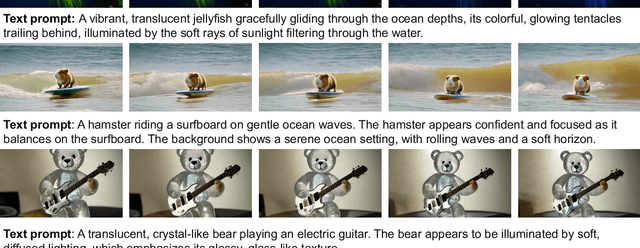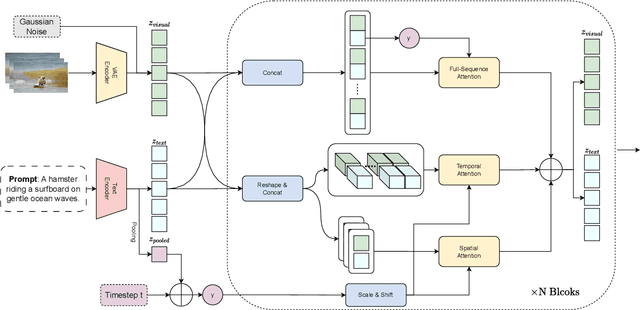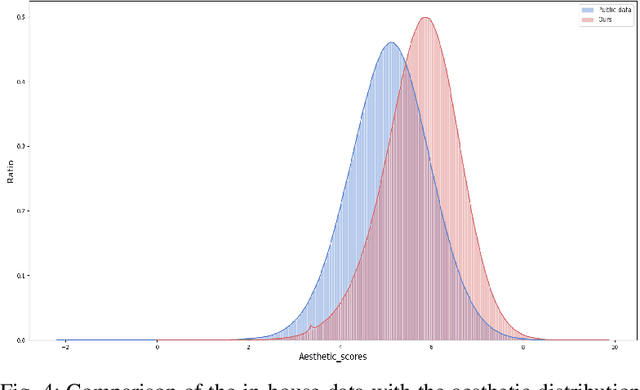Ziqi Huang
VBench-2.0: Advancing Video Generation Benchmark Suite for Intrinsic Faithfulness
Mar 27, 2025Abstract:Video generation has advanced significantly, evolving from producing unrealistic outputs to generating videos that appear visually convincing and temporally coherent. To evaluate these video generative models, benchmarks such as VBench have been developed to assess their faithfulness, measuring factors like per-frame aesthetics, temporal consistency, and basic prompt adherence. However, these aspects mainly represent superficial faithfulness, which focus on whether the video appears visually convincing rather than whether it adheres to real-world principles. While recent models perform increasingly well on these metrics, they still struggle to generate videos that are not just visually plausible but fundamentally realistic. To achieve real "world models" through video generation, the next frontier lies in intrinsic faithfulness to ensure that generated videos adhere to physical laws, commonsense reasoning, anatomical correctness, and compositional integrity. Achieving this level of realism is essential for applications such as AI-assisted filmmaking and simulated world modeling. To bridge this gap, we introduce VBench-2.0, a next-generation benchmark designed to automatically evaluate video generative models for their intrinsic faithfulness. VBench-2.0 assesses five key dimensions: Human Fidelity, Controllability, Creativity, Physics, and Commonsense, each further broken down into fine-grained capabilities. Tailored for individual dimensions, our evaluation framework integrates generalists such as state-of-the-art VLMs and LLMs, and specialists, including anomaly detection methods proposed for video generation. We conduct extensive annotations to ensure alignment with human judgment. By pushing beyond superficial faithfulness toward intrinsic faithfulness, VBench-2.0 aims to set a new standard for the next generation of video generative models in pursuit of intrinsic faithfulness.
RepVideo: Rethinking Cross-Layer Representation for Video Generation
Jan 15, 2025



Abstract:Video generation has achieved remarkable progress with the introduction of diffusion models, which have significantly improved the quality of generated videos. However, recent research has primarily focused on scaling up model training, while offering limited insights into the direct impact of representations on the video generation process. In this paper, we initially investigate the characteristics of features in intermediate layers, finding substantial variations in attention maps across different layers. These variations lead to unstable semantic representations and contribute to cumulative differences between features, which ultimately reduce the similarity between adjacent frames and negatively affect temporal coherence. To address this, we propose RepVideo, an enhanced representation framework for text-to-video diffusion models. By accumulating features from neighboring layers to form enriched representations, this approach captures more stable semantic information. These enhanced representations are then used as inputs to the attention mechanism, thereby improving semantic expressiveness while ensuring feature consistency across adjacent frames. Extensive experiments demonstrate that our RepVideo not only significantly enhances the ability to generate accurate spatial appearances, such as capturing complex spatial relationships between multiple objects, but also improves temporal consistency in video generation.
Vchitect-2.0: Parallel Transformer for Scaling Up Video Diffusion Models
Jan 14, 2025



Abstract:We present Vchitect-2.0, a parallel transformer architecture designed to scale up video diffusion models for large-scale text-to-video generation. The overall Vchitect-2.0 system has several key designs. (1) By introducing a novel Multimodal Diffusion Block, our approach achieves consistent alignment between text descriptions and generated video frames, while maintaining temporal coherence across sequences. (2) To overcome memory and computational bottlenecks, we propose a Memory-efficient Training framework that incorporates hybrid parallelism and other memory reduction techniques, enabling efficient training of long video sequences on distributed systems. (3) Additionally, our enhanced data processing pipeline ensures the creation of Vchitect T2V DataVerse, a high-quality million-scale training dataset through rigorous annotation and aesthetic evaluation. Extensive benchmarking demonstrates that Vchitect-2.0 outperforms existing methods in video quality, training efficiency, and scalability, serving as a suitable base for high-fidelity video generation.
Evaluation Agent: Efficient and Promptable Evaluation Framework for Visual Generative Models
Dec 10, 2024Abstract:Recent advancements in visual generative models have enabled high-quality image and video generation, opening diverse applications. However, evaluating these models often demands sampling hundreds or thousands of images or videos, making the process computationally expensive, especially for diffusion-based models with inherently slow sampling. Moreover, existing evaluation methods rely on rigid pipelines that overlook specific user needs and provide numerical results without clear explanations. In contrast, humans can quickly form impressions of a model's capabilities by observing only a few samples. To mimic this, we propose the Evaluation Agent framework, which employs human-like strategies for efficient, dynamic, multi-round evaluations using only a few samples per round, while offering detailed, user-tailored analyses. It offers four key advantages: 1) efficiency, 2) promptable evaluation tailored to diverse user needs, 3) explainability beyond single numerical scores, and 4) scalability across various models and tools. Experiments show that Evaluation Agent reduces evaluation time to 10% of traditional methods while delivering comparable results. The Evaluation Agent framework is fully open-sourced to advance research in visual generative models and their efficient evaluation.
VBench++: Comprehensive and Versatile Benchmark Suite for Video Generative Models
Nov 20, 2024



Abstract:Video generation has witnessed significant advancements, yet evaluating these models remains a challenge. A comprehensive evaluation benchmark for video generation is indispensable for two reasons: 1) Existing metrics do not fully align with human perceptions; 2) An ideal evaluation system should provide insights to inform future developments of video generation. To this end, we present VBench, a comprehensive benchmark suite that dissects "video generation quality" into specific, hierarchical, and disentangled dimensions, each with tailored prompts and evaluation methods. VBench has several appealing properties: 1) Comprehensive Dimensions: VBench comprises 16 dimensions in video generation (e.g., subject identity inconsistency, motion smoothness, temporal flickering, and spatial relationship, etc). The evaluation metrics with fine-grained levels reveal individual models' strengths and weaknesses. 2) Human Alignment: We also provide a dataset of human preference annotations to validate our benchmarks' alignment with human perception, for each evaluation dimension respectively. 3) Valuable Insights: We look into current models' ability across various evaluation dimensions, and various content types. We also investigate the gaps between video and image generation models. 4) Versatile Benchmarking: VBench++ supports evaluating text-to-video and image-to-video. We introduce a high-quality Image Suite with an adaptive aspect ratio to enable fair evaluations across different image-to-video generation settings. Beyond assessing technical quality, VBench++ evaluates the trustworthiness of video generative models, providing a more holistic view of model performance. 5) Full Open-Sourcing: We fully open-source VBench++ and continually add new video generation models to our leaderboard to drive forward the field of video generation.
WiCV@CVPR2024: The Thirteenth Women In Computer Vision Workshop at the Annual CVPR Conference
Nov 03, 2024Abstract:In this paper, we present the details of Women in Computer Vision Workshop - WiCV 2024, organized alongside the CVPR 2024 in Seattle, Washington, United States. WiCV aims to amplify the voices of underrepresented women in the computer vision community, fostering increased visibility in both academia and industry. We believe that such events play a vital role in addressing gender imbalances within the field. The annual WiCV@CVPR workshop offers a)~opportunity for collaboration between researchers from minority groups, b) mentorship for female junior researchers, c) financial support to presenters to alleviate financial burdens and d)~a diverse array of role models who can inspire younger researchers at the outset of their careers. In this paper, we present a comprehensive report on the workshop program, historical trends from the past WiCV@CVPR events, and a summary of statistics related to presenters, attendees, and sponsorship for the WiCV 2024 workshop.
FreeInit: Bridging Initialization Gap in Video Diffusion Models
Dec 12, 2023



Abstract:Though diffusion-based video generation has witnessed rapid progress, the inference results of existing models still exhibit unsatisfactory temporal consistency and unnatural dynamics. In this paper, we delve deep into the noise initialization of video diffusion models, and discover an implicit training-inference gap that attributes to the unsatisfactory inference quality. Our key findings are: 1) the spatial-temporal frequency distribution of the initial latent at inference is intrinsically different from that for training, and 2) the denoising process is significantly influenced by the low-frequency components of the initial noise. Motivated by these observations, we propose a concise yet effective inference sampling strategy, FreeInit, which significantly improves temporal consistency of videos generated by diffusion models. Through iteratively refining the spatial-temporal low-frequency components of the initial latent during inference, FreeInit is able to compensate the initialization gap between training and inference, thus effectively improving the subject appearance and temporal consistency of generation results. Extensive experiments demonstrate that FreeInit consistently enhances the generation results of various text-to-video generation models without additional training.
VBench: Comprehensive Benchmark Suite for Video Generative Models
Nov 29, 2023Abstract:Video generation has witnessed significant advancements, yet evaluating these models remains a challenge. A comprehensive evaluation benchmark for video generation is indispensable for two reasons: 1) Existing metrics do not fully align with human perceptions; 2) An ideal evaluation system should provide insights to inform future developments of video generation. To this end, we present VBench, a comprehensive benchmark suite that dissects "video generation quality" into specific, hierarchical, and disentangled dimensions, each with tailored prompts and evaluation methods. VBench has three appealing properties: 1) Comprehensive Dimensions: VBench comprises 16 dimensions in video generation (e.g., subject identity inconsistency, motion smoothness, temporal flickering, and spatial relationship, etc). The evaluation metrics with fine-grained levels reveal individual models' strengths and weaknesses. 2) Human Alignment: We also provide a dataset of human preference annotations to validate our benchmarks' alignment with human perception, for each evaluation dimension respectively. 3) Valuable Insights: We look into current models' ability across various evaluation dimensions, and various content types. We also investigate the gaps between video and image generation models. We will open-source VBench, including all prompts, evaluation methods, generated videos, and human preference annotations, and also include more video generation models in VBench to drive forward the field of video generation.
LAVIE: High-Quality Video Generation with Cascaded Latent Diffusion Models
Sep 27, 2023Abstract:This work aims to learn a high-quality text-to-video (T2V) generative model by leveraging a pre-trained text-to-image (T2I) model as a basis. It is a highly desirable yet challenging task to simultaneously a) accomplish the synthesis of visually realistic and temporally coherent videos while b) preserving the strong creative generation nature of the pre-trained T2I model. To this end, we propose LaVie, an integrated video generation framework that operates on cascaded video latent diffusion models, comprising a base T2V model, a temporal interpolation model, and a video super-resolution model. Our key insights are two-fold: 1) We reveal that the incorporation of simple temporal self-attentions, coupled with rotary positional encoding, adequately captures the temporal correlations inherent in video data. 2) Additionally, we validate that the process of joint image-video fine-tuning plays a pivotal role in producing high-quality and creative outcomes. To enhance the performance of LaVie, we contribute a comprehensive and diverse video dataset named Vimeo25M, consisting of 25 million text-video pairs that prioritize quality, diversity, and aesthetic appeal. Extensive experiments demonstrate that LaVie achieves state-of-the-art performance both quantitatively and qualitatively. Furthermore, we showcase the versatility of pre-trained LaVie models in various long video generation and personalized video synthesis applications.
WiCV@CVPR2023: The Eleventh Women In Computer Vision Workshop at the Annual CVPR Conference
Sep 22, 2023Abstract:In this paper, we present the details of Women in Computer Vision Workshop - WiCV 2023, organized alongside the hybrid CVPR 2023 in Vancouver, Canada. WiCV aims to amplify the voices of underrepresented women in the computer vision community, fostering increased visibility in both academia and industry. We believe that such events play a vital role in addressing gender imbalances within the field. The annual WiCV@CVPR workshop offers a) opportunity for collaboration between researchers from minority groups, b) mentorship for female junior researchers, c) financial support to presenters to alleviate finanacial burdens and d) a diverse array of role models who can inspire younger researchers at the outset of their careers. In this paper, we present a comprehensive report on the workshop program, historical trends from the past WiCV@CVPR events, and a summary of statistics related to presenters, attendees, and sponsorship for the WiCV 2023 workshop.
 Add to Chrome
Add to Chrome Add to Firefox
Add to Firefox Add to Edge
Add to Edge